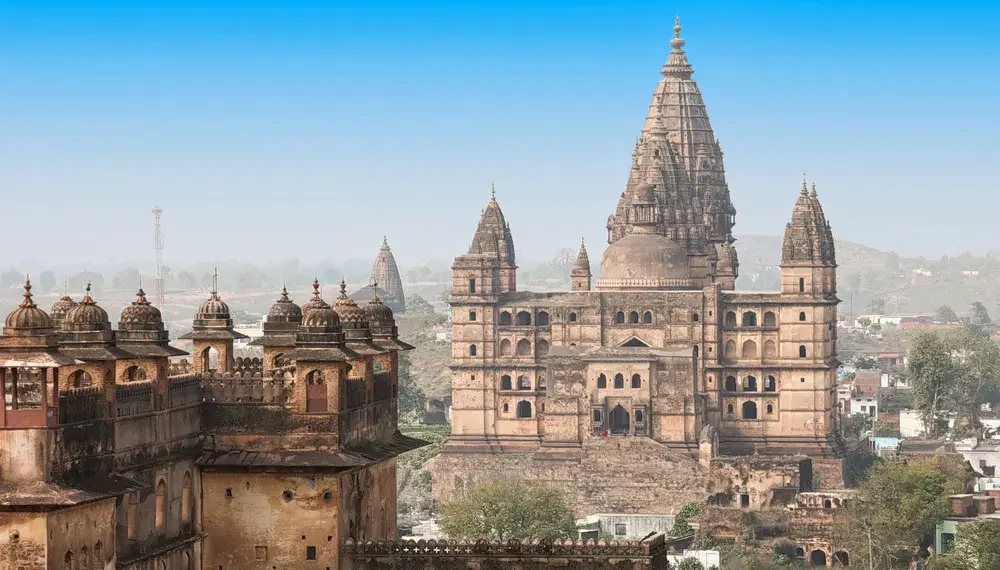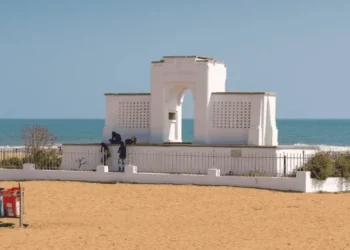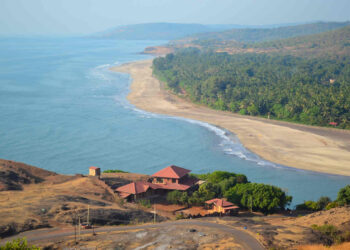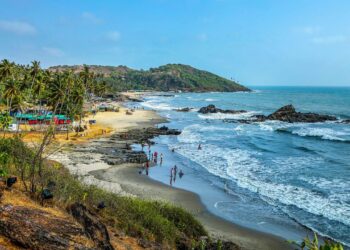Chaturbhuj Temple is a sacred shrine set high in the old town of Orchha, Madhya Pradesh, along the Betwa River. Built long ago, around 1570 AD, by King Madhukar Shah of the Bundela dynasty, this temple is dedicated to Lord Rama, an avatar of Vishnu. The temple has quite a complex multi-storied structural view which is a blend of temple, fort and palatial architectural features.
Notable Fact: The temple was built for Lord Rama’s idol, meant to be housed here, but the idol stayed in the queen’s palace, now the Ram Raja Temple. At present an image of Radha Krishna is worshiped in the temple.
Overview of Chaturbhuj Temple
The Chaturbhuj Temple stands tall in Orchha, named “four-armed” for Vishnu’s form. The Chaturbhuj Temple, though empty of its main idol, remains a holy site. Its high walls, dome-like top, and mix of Hindu and Mughal styles show the Bundela’s craft. The temple’s size and view over Orchha make it grand. The Archaeological Survey of India keeps it as a special monument, strong and plain, despite years of wear.
History of Chaturbhuj Temple
Old tales say King Madhukar Shah built the temple in 1570 AD after a dream of Lord Rama. His wife, Queen Ganesh Kunwari, brought a Rama idol from Ayodhya, meant for this shrine. When the idol was placed in her palace during the temple’s construction, it would not budge, so the palace became Ram Raja Temple. The Chaturbhuj Temple was left for other Vishnu forms. In the 1600s, Mughal raids harmed Orchha, but the temple stood firm. After 1947, the state took charge, keeping it safe. Repairs by the Archaeological Survey fixed old stones, kept them true. Long ago, priests sang Rama’s name here, and tales spread wide. Now, visitors climb its steps to see this holy ground, this true ground.
Legend of Chaturbhuj Temple
According to a local legend, the temple was built after the queen had a “dream visitation” by Lord Rama directing her to build a temple for Him; while Madhukar Shah was a devotee of Krishna, his wife’s dedication was to Rama. Following the approval to build the Chaturbhuja Temple, the queen went to Ayodhya to obtain an image of Lord Rama that was to be enshrined in her new temple. When she came back from Ayodhya with the image of Rama, initially she kept the idol in her palace, called Rani Mahal, as the Chaturbhuj Temple was still under construction. She was, however, unaware of an injunction that the image to be deified in a temple could not be kept in a palace. Once the temple construction was completed and the idol of the lord had to be moved for installation at the Chatrubhuj Temple, it refused to be shifted from the palace. Hence, instead of the Chaturbuj temple, the Rama’s idol remained in the palace whereas the Chaturbhuj Temple remained without an idol in its sanctum. As Rama was worshiped in the palace it was converted into the Ram Raja Temple; it is the only shrine in the country where Rama is worshiped as a king.
Architecture of Chaturbhuj Temple
The Chaturbhuj Temple rises on a high stone base, reached by steep steps. Its main hall, 100 feet long, has a dome-like top, not a spire, blending Hindu and Mughal ways. The yellow stone walls have deep carvings of flowers, gods, and birds, all fine work. Inside, the sanctum, meant for Rama, now holds a small Vishnu idol, plain but holy. The hall’s high ceiling has arches, like Mughal forts, and small windows let in soft light. Four smaller domes sit at the corners, giving it a castle-like look.
The outer walls show Vishnu’s tales—his forms like Krishna and Narayana—mixed with daily life, like folks working or dancing. A porch at the entry has neat stone patterns, real fine. No river is near, but the Betwa, a short walk away, serves for holy baths. The temple’s high spot gives a wide view of Orchha’s green lands, making the air feel sacred, real sacred. Walls guide them who pray, telling old stories.
Sculptures of Chaturbhuj Temple
The temple’s walls and pillars carry deep carvings. Vishnu’s forms, like Krishna with a flute or Rama with a bow, stand out clear and strong. Other gods, like Lakshmi and Ganesh, appear too. Scenes of daily life show women with pots, men with tools, cut neat and lively. The inner hall has fewer carvings, mostly floral marks, but they’re fine. Some statues broke over time, but many stay, showing the old skill. A special carving on the porch shows a dancing maid, her pose light and true. The work feels like Orchha’s own style, softer than Khajuraho’s. The stones pull the heart to marvel at their craft.
Information for Travelers
Hours and Entry: Open daily, 6:00 AM to 5:00 PM. Entry is free for all, a fair deal. No photos are banned, but respect the holy space.
Clothing: Wear clothes covering shoulders and knees, proper and plain. For prayers, women wear sarees or suits, men wear kurtas, plain kurtas.
How to Get There:
Air: Gwalior Airport, 120 km away, is closest. Taxis take 2.5 hours, cost ₹2000–3000, a steady trip.
Train: Jhansi Station, 18 km away, links to Delhi, 6 hours long. Autos cost ₹200–400, a small fare.
Road: Buses from Jhansi, 30 minutes away, reach Orchha. Taxis cost ₹500–1000, calm roads, steady roads.
Best Time to Visit:
October to March, cool air, 15–25°C. Weekdays are quiet, real quiet. Summer, April to June, is too hot, skip it.
Nearby Attractions:
Ram Raja Temple, 1 km away, a Rama shrine, lively and holy.
Jehangir Mahal, 1 km off, a Mughal palace, grand stones.
Raja Mahal, 1 km away, a Bundela palace, fine walls.
Lakshmi Narayan Temple, 2 km off, a Vishnu shrine, neat carvings.
Cenotaphs of Orchha, 1 km away, royal tombs, calm spot.











